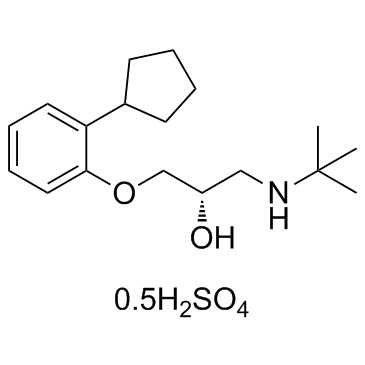Interaction studies of 5-HT1A receptor antagonists and selective 5-HT reuptake inhibitors in isolated aggressive mice.
C Sànchez
Index: Eur. J. Pharmacol. 334(2-3) , 127-32, (1997)
Full Text: HTML
Abstract
Recently published studies have suggested that behavioral and neurochemical changes induced by selective serotonin (5-hydroxytryptamine, 5-HT) reuptake inhibitors are potentiated by coadministration of a 5-HT1A receptor antagonist. The potentiating effect is hypothesized to be due to antagonism of somatodendritic 5-HT1A autoreceptors. In the present study the effects of concomitant administration of a selective 5-HT reuptake inhibitor with a 5-HT1A receptor antagonist (N-[2-[4-(2-methoxyphenyl)-1-piperazinyl] ethyl]-N-(2-pyridinyl) cyclo-hexanecarboxamide (WAY 100635) or a beta-adrenoceptor and 5-HT1A/1B receptor antagonist (pindolol or (-)-penbutolol) were studied in isolated aggressive mice. WAY 100635 was inactive, but high doses of WAY 100635 produced a marked anti-aggressive effect when combined with a non-effective dose of citalopram or paroxetine. Low doses of pindolol, but not (-)-penbutolol, produced a minor but significant anti-aggressive effect in combination with citalopram or paroxetine. High doses of pindolol or (-)-penbutolol inhibited aggressive behavior, an effect which was reversed by citalopram or paroxetine. The beta-adrenoceptor antagonist, metoprolol, but not the alpha1-adrenoceptor antagonist, prazosin, facilitated the anti aggressive effect of citalopram. The significance of these findings is discussed relative to the above hypothesis.
Related Compounds
| Structure | Name/CAS No. | Molecular Formula | Articles |
|---|---|---|---|
 |
Penbutolol sulfate
CAS:38363-32-5 |
C18H29NO2.1/2H2O4S |
|
5-HT receptor subtypes involved in the spinal antinociceptiv...
2001-11-30 [Eur. J. Pharmacol. 432(1) , 1-7, (2001)] |
|
Autoreceptors remain functional after prolonged treatment wi...
1999-07-24 [Brain Res. 835(2) , 224-8, (1999)] |
|
Affinity of (+/-)-pindolol, (-)-penbutolol, and (-)-tertatol...
2000-08-01 [J. Neurochem. 75(2) , 755-62, (2000)] |
|
The antiaggressive potency of (-)-penbutolol involves both 5...
1996-02-15 [Eur. J. Pharmacol. 297(1-2) , 1-8, (1996)] |
|
High-performance liquid chromatography with chemiluminescenc...
2001-06-15 [J. Chromatogr. B. Biomed. Sci. Appl. 757(2) , 229-35, (2001)] |